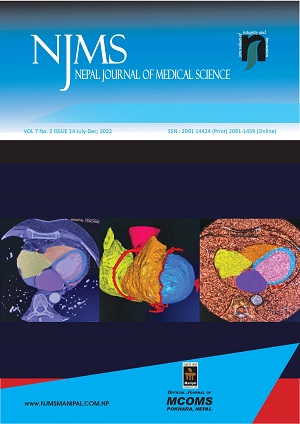The Contribution of Alvarado Score and Ultrasonography to the Diagnosis of Childhood Appendicitis during and before COVID-19 Pandemic Period
DOI:
https://doi.org/10.3126/njms.v7i2.47259Keywords:
Appendicitis, COVID-19 Pandemic, UltrasonographyAbstract
Introduction: This study aimed to evaluate the changes made by the pandemic in pediatric appendicitis, the Alvarado score and the contribution of ultrasonography to the diagnosis.
Methods: This study was conducted on patients who underwent surgery for appendicitis to compare the COVID-19 pandemic period versus the same period the year before. Data regarding demographics, age, the time between symptom onset and admission to hospital, laboratory, ultrasonography and pathology results and Alvarado score were considered.
Results: A total of 211 patients were operated on for appendicitis, 132 patients in the control group and 79 patients in the COVID-19 group. No significant differences between the groups in terms of age, gender and the distribution of appendicitis severity were found. The median time between the onset of symptoms and admission to the hospital was 2.72 days during the COVID-19 pandemic period and there was a significant difference between the two groups(p=0.043). Alvarado score and ultrasonography were evaluated together, in the control group sensitivity 98.4%, specificity 87.5%, PPV 96.9% and NPV 93.3%; if in the COVID-19 group were 94.5%, 88.8%, 97.2% and 80%, respectively.
Conclusions: This study has shown that the evaluation of the Alvarado score and ultrasonography together, increases both sensitivity and specificity for the diagnosis of childhood appendicitis. That's why the combination of these tests becomes more important in special situations such as the COVID-19 period.
Downloads
Downloads
Published
How to Cite
Issue
Section
License
Copyright (c) 2022 Nepal Journal of Medical Sciences

This work is licensed under a Creative Commons Attribution 4.0 International License.
Copyright © by Nepal Journal of Medical Sciences. The ideas and opinions expressed by authors of articles summarized, quoted, or published in full text in this Journal represents only opinions of authors and do not necessarily reflect the official policy of Nepal Journal of Medical Sciences or the institute with which the author(s) is (are) affiliated, unless so specified.




